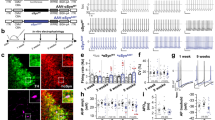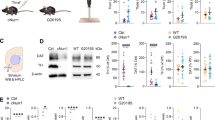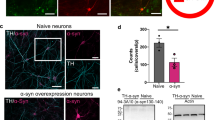Abstract
Parkinson's disease is a common neurodegenerative disorder characterized by a profound motor disability that is traceable to the emergence of synchronous, rhythmic spiking in neurons of the external segment of the globus pallidus (GPe). The origins of this pathophysiology are poorly defined for the generation of pacemaking. After the induction of a parkinsonian state in mice, there was a progressive decline in autonomous GPe pacemaking, which normally serves to desynchronize activity. The loss was attributable to the downregulation of an ion channel that is essential in pacemaking, the hyperpolarization and cyclic nucleotide–gated (HCN) channel. Viral delivery of HCN2 subunits restored pacemaking and reduced burst spiking in GPe neurons. However, the motor disability induced by dopamine (DA) depletion was not reversed, suggesting that the loss of pacemaking was a consequence, rather than a cause, of key network pathophysiology, a conclusion that is consistent with the ability of L-type channel antagonists to attenuate silencing after DA depletion.
This is a preview of subscription content, access via your institution
Access options
Subscribe to this journal
Receive 12 print issues and online access
$209.00 per year
only $17.42 per issue
Buy this article
- Purchase on Springer Link
- Instant access to full article PDF
Prices may be subject to local taxes which are calculated during checkout







Similar content being viewed by others
References
DeLong, M.R. & Wichmann, T. Circuits and circuit disorders of the basal ganglia. Arch. Neurol. 64, 20–24 (2007).
Hammond, C., Bergman, H. & Brown, P. Pathological synchronization in Parkinson's disease: networks, models and treatments. Trends Neurosci. 30, 357–364 (2007).
Rivlin-Etzion, M. et al. Basal ganglia oscillations and pathophysiology of movement disorders. Curr. Opin. Neurobiol. 16, 629–637 (2006).
Graybiel, A.M. Habits, rituals, and the evaluative brain. Annu. Rev. Neurosci. 31, 359–387 (2008).
DeLong, M.R. Activity of pallidal neurons during movement. J. Neurophysiol. 34, 414–427 (1971).
Chan, C.S., Shigemoto, R., Mercer, J.N. & Surmeier, D.J. HCN2 and HCN1 channels govern the regularity of autonomous pacemaking and synaptic resetting in globus pallidus neurons. J. Neurosci. 24, 9921–9932 (2004).
Stanford, I.M. Independent neuronal oscillators of the rat globus pallidus. J. Neurophysiol. 89, 1713–1717 (2003).
Kita, H. & Kitai, S.T. Intracellular study of rat globus pallidus neurons: membrane properties and responses to neostriatal, subthalamic and nigral stimulation. Brain Res. 564, 296–305 (1991).
Nambu, A. & Llinas, R. Electrophysiology of globus pallidus neurons in vitro. J. Neurophysiol. 72, 1127–1139 (1994).
Bevan, M.D., Magill, P.J., Terman, D., Bolam, J.P. & Wilson, C.J. Move to the rhythm: oscillations in the subthalamic nucleus-external globus pallidus network. Trends Neurosci. 25, 525–531 (2002).
Obeso, J.A. et al. Pathophysiology of the basal ganglia in Parkinson's disease. Trends Neurosci. 23, S8–S19 (2000).
Walters, J.R., Ruskin, D.N., Allers, K.A. & Bergstrom, D.A. Pre- and postsynaptic aspects of dopamine-mediated transmission. Trends Neurosci. 23, S41–S47 (2000).
Mallet, N., Ballion, B., Le Moine, C. & Gonon, F. Cortical inputs and GABA interneurons imbalance projection neurons in the striatum of parkinsonian rats. J. Neurosci. 26, 3875–3884 (2006).
Terman, D., Rubin, J.E., Yew, A.C. & Wilson, C.J. Activity patterns in a model for the subthalamopallidal network of the basal ganglia. J. Neurosci. 22, 2963–2976 (2002).
Gillies, A., Willshaw, D. & Li, Z. Subthalamic-pallidal interactions are critical in determining normal and abnormal functioning of the basal ganglia. Proc. R. Soc. Lond. B 269, 545–551 (2002).
Surmeier, D.J., Mercer, J.N. & Chan, C.S. Autonomous pacemakers in the basal ganglia: who needs excitatory synapses anyway? Curr. Opin. Neurobiol. 15, 312–318 (2005).
Mercer, J.N., Chan, C.S., Tkatch, T., Held, J. & Surmeier, D.J. Nav1.6 sodium channels are critical to pacemaking and fast spiking in globus pallidus neurons. J. Neurosci. 27, 13552–13566 (2007).
Zhang, W. & Linden, D.J. The other side of the engram: experience-driven changes in neuronal intrinsic excitability. Nat. Rev. Neurosci. 4, 885–900 (2003).
Turrigiano, G.G. & Nelson, S.B. Homeostatic plasticity in the developing nervous system. Nat. Rev. Neurosci. 5, 97–107 (2004).
Iancu, R., Mohapel, P., Brundin, P. & Paul, G. Behavioral characterization of a unilateral 6-OHDA-lesion model of Parkinson's disease in mice. Behav. Brain Res. 162, 1–10 (2005).
Schallert, T., Fleming, S.M., Leasure, J.L., Tillerson, J.L. & Bland, S.T. CNS plasticity and assessment of forelimb sensorimotor outcome in unilateral rat models of stroke, cortical ablation, parkinsonism and spinal cord injury. Neuropharmacology 39, 777–787 (2000).
Albin, R.L., Young, A.B. & Penney, J.B. The functional anatomy of basal ganglia disorders. Trends Neurosci. 12, 366–375 (1989).
Shin, R.M. et al. Dopamine D4 receptor-induced postsynaptic inhibition of GABAergic currents in mouse globus pallidus neurons. J. Neurosci. 23, 11662–11672 (2003).
Cooper, A.J. & Stanford, I.M. Dopamine D2 receptor mediated presynaptic inhibition of striatopallidal GABA(A) IPSCs in vitro. Neuropharmacology 41, 62–71 (2001).
Watanabe, K. Kita, T. & Kita, H. Presynaptic actions of D2-like receptors in the rat cortico-striato-globus pallidus disynaptic connection in vitro. J. Neurophysiol 101, 665–671 (2009).
Chan, C.S. et al. 'Rejuvenation' protects neurons in mouse models of Parkinson's disease. Nature 447, 1081–1086 (2007).
Biel, M., Wahl-Schott, C., Michalakis, S. & Zong, X. Hyperpolarization-activated cation channels: from genes to function. Physiol. Rev. 89, 847–885 (2009).
Lewis, A.S. et al. Alternatively spliced isoforms of TRIP8b differentially control h channel trafficking and function. J. Neurosci. 29, 6250–6265 (2009).
Santoro, B., Wainger, B.J. & Siegelbaum, S.A. Regulation of HCN channel surface expression by a novel C-terminal protein-protein interaction. J. Neurosci. 24, 10750–10762 (2004).
Notomi, T. & Shigemoto, R. Immunohistochemical localization of Ih channel subunits, HCN1–4, in the rat brain. J. Comp. Neurol. 471, 241–276 (2004).
Chung, W.K. et al. Absence epilepsy in apathetic, a spontaneous mutant mouse lacking the h channel subunit, HCN2. Neurobiol. Dis. 33, 499–508 (2009).
Nolan, M.F. et al. The hyperpolarization-activated HCN1 channel is important for motor learning and neuronal integration by cerebellar Purkinje cells. Cell 115, 551–564 (2003).
Galati, S. et al. The pharmacological blockade of medial forebrain bundle induces an acute pathological synchronization of the cortico-subthalamic nucleus-globus pallidus pathway. J. Physiol. (Lond.) 587, 4405–4423 (2009).
Heimer, G., Bar-Gad, I., Goldberg, J.A. & Bergman, H. Dopamine replacement therapy reverses abnormal synchronization of pallidal neurons in the 1-methyl-4-phenyl-1,2,3,6-tetrahydropyridine primate model of parkinsonism. J. Neurosci. 22, 7850–7855 (2002).
Walters, J.R., Hu, D., Itoga, C.A., Parr-Brownlie, L.C. & Bergstrom, D.A. Phase relationships support a role for coordinated activity in the indirect pathway in organizing slow oscillations in basal ganglia output after loss of dopamine. Neuroscience 144, 762–776 (2007).
Mallet, N. et al. Parkinsonian beta oscillations in the external globus pallidus and their relationship with subthalamic nucleus activity. J. Neurosci. 28, 14245–14258 (2008).
Shah, M.M., Anderson, A.E., Leung, V., Lin, X. & Johnston, D. Seizure-induced plasticity of h channels in entorhinal cortical layer III pyramidal neurons. Neuron 44, 495–508 (2004).
Strauss, U. et al. An impaired neocortical Ih is associated with enhanced excitability and absence epilepsy. Eur. J. Neurosci. 19, 3048–3058 (2004).
Kole, M.H., Brauer, A.U. & Stuart, G.J. Inherited cortical HCN1 channel loss amplifies dendritic calcium electrogenesis and burst firing in a rat absence epilepsy model. J. Physiol. (Lond.) 578, 507–525 (2007).
Destexhe, A. & Marder, E. Plasticity in single neuron and circuit computations. Nature 431, 789–795 (2004).
Zucker, R.S. Calcium- and activity-dependent synaptic plasticity. Curr. Opin. Neurobiol. 9, 305–313 (1999).
Xu, W. & Lipscombe, D. Neuronal Ca(V)1.3alpha(1) L-type channels activate at relatively hyperpolarized membrane potentials and are incompletely inhibited by dihydropyridines. J. Neurosci. 21, 5944–5951 (2001).
Robinson, R.B. & Siegelbaum, S.A. Hyperpolarization-activated cation currents: from molecules to physiological function. Annu. Rev. Physiol. 65, 453–480 (2003).
Hernández, A. et al. Control of the subthalamic innervation of the rat globus pallidus by D2/3 and D4 dopamine receptors. J. Neurophysiol. 96, 2877–2888 (2006).
Higley, M.J. & Sabatini, B.L. Competitive regulation of synaptic Ca2+ influx by D2 dopamine and A2A adenosine receptors. Nat. Neurosci. 13, 958–966 (2010).
Fleming, S.M. et al. Early and progressive sensorimotor anomalies in mice overexpressing wild-type human α-synuclein. J. Neurosci. 24, 9434–9440 (2004).
Blume, S.R., Cass, D.K. & Tseng, K.Y. Stepping test in mice: a reliable approach in determining forelimb akinesia in MPTP-induced Parkinsonism. Exp. Neurol. 219, 208–211 (2009).
Acknowledgements
We thank Y. Chen, K. Saporito and S. Ulrich for technical assistance. This work was supported by grants from the Parkinson's Disease Foundation and American Parkinson Disease Association Research to C.S.C.; a grant from the Michael J. Fox Foundation to P.O.; a grant from the Hartmann Foundation to D.J.S. and US National Institutes of Health grants NS069777 to C.S.C., MH082522 to T.S.G., NS064757 to A.S.L., NS05595 and NS059934 to D.M.C., NS042762 to H.K. and NS047085 to D.J.S.
Author information
Authors and Affiliations
Contributions
C.S.C. and D.J.S. conceived the study, designed the experiments and directed the project. K.E.G. and P.O. designed the viral expression strategy and generated and validated the HCN2 vectors in vitro and in vivo. C.S.C., T.S.G., J.N.G., J.N.M. and H.K. carried out the recordings. A.S.L., R.S. and D.M.C. provided HCN mutants, generated the antibodies and carried out the western blots. C.S.C., A.B.G. and K.E.G. designed the probes and carried out the qPCRs. T.T. participated in the exploratory phase of the qPCR experiments. K.E.G and S.M.F. carried out the behavioral analyses. C.S.C. and D.J.S. wrote the paper. All authors discussed the results and implications and commented on the manuscript at all stages.
Corresponding author
Ethics declarations
Competing interests
The authors declare no competing financial interests.
Supplementary information
Supplementary Text and Figures
Supplementary Figures 1–7 (PDF 2220 kb)
Rights and permissions
About this article
Cite this article
Chan, C., Glajch, K., Gertler, T. et al. HCN channelopathy in external globus pallidus neurons in models of Parkinson's disease. Nat Neurosci 14, 85–92 (2011). https://doi.org/10.1038/nn.2692
Received:
Accepted:
Published:
Issue Date:
DOI: https://doi.org/10.1038/nn.2692
This article is cited by
-
Pallidal GABA B receptors: involvement in cortex beta dynamics and thalamic reticular nucleus activity
The Journal of Physiological Sciences (2023)
-
Cell and circuit complexity of the external globus pallidus
Nature Neuroscience (2023)
-
Elevation of GABA levels in the globus pallidus disinhibits the thalamic reticular nucleus and desynchronized cortical beta oscillations
The Journal of Physiological Sciences (2022)
-
Central Nervous System Targets: Inhibitory Interneurons in the Spinal Cord
Neurotherapeutics (2020)
-
Cardiac and neuronal HCN channelopathies
Pflügers Archiv - European Journal of Physiology (2020)



